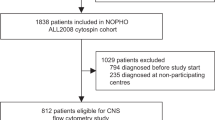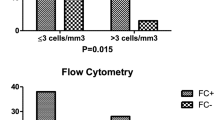Abstract
Background
Usually, central nervous system (CNS) involvement in acute lymphoblastic leukemia (ALL) is diagnosed by cytomorphology (CM) of cerebrospinal fluid (CSF) on cytospin slides. Multicolor flow cytometry (MFC) provides the opportunity to detect low numbers of leukemia cells undetectable by CM. The present study aimed at evaluating the clinical significance of MFC for the diagnosis of CNS involvement at initial manifestation of childhood ALL.
Methods
In 155 children with ALL, CSF samples were studied in parallel by CM and MFC. Patients were treated according to protocol ALL-MB-2008 for childhood ALL. The prognostic impact of the leukemia burden in CSF was determined categorizing the findings as positive/negative. In addition, the absolute blast cell count per 1 ml of CSF was studied as a continuous variable.
Results
CSF positivity was significantly more frequent using MFC compared with CM (35.3% vs. 15.3% of patients). The outcome of MFC-positive and MFC-negative patients was not different in clinically relevant patient risk groups—CNS1, standard and intermediate-risk groups. Using the quantitative approach, at the threshold level of 20 blasts per ml of CSF, patients could be divided into two groups with a significantly different outcome, irrespective of the clinical risk group, the type of CNS-directed therapy, and the CNS status determined by CM.
Conclusions
Our data do not support the concept of re-stratification and modification of therapy based on qualitative CSF investigation by MFC. However, MFC is a highly sensitive technique of CSF investigation improving the definition of CNS involvement in childhood ALL, and quantitative measurement of blast cells in CSF, if well-organized, can be a useful additional tool for stratification of patients in clinical trials.







Similar content being viewed by others
References
Basso G et al (2009) Risk of relapse of childhood acute lymphoblastic leukemia is predicted by flow cytometric measurement of residual disease on day 15 bone marrow. J Clin Oncol 27:5168–5174. https://doi.org/10.1200/JCO.2008.20.8934
Burger B et al (2003) Diagnostic cerebrospinal fluid examination in children with acute lymphoblastic leukemia: significance of low leukocyte counts with blasts or traumatic lumbar puncture. J Clin Oncol 21:184–188. https://doi.org/10.1200/JCO.2003.04.096
Cancela CSP, Murao M, Assumpcao JG, Souza MEL, de Macedo AV, Viana MB, De Oliveira BM (2017) Immunophenotyping of the cerebrospinal fluid as a prognostic factor at diagnosis of acute lymphoblastic leukemia in children and adolescents. Pediatr Hematol Oncol 34:53–65. https://doi.org/10.1080/08880018.2017.1313920
Conter V et al (2010) Molecular response to treatment redefines all prognostic factors in children and adolescents with B-cell precursor acute lymphoblastic leukemia: results in 3184 patients of the AIEOP-BFM ALL 2000 study. Blood 115:3206–3214. https://doi.org/10.1182/blood-2009-10-248146
Coustan-Smith E et al (2000) Clinical importance of minimal residual disease in childhood acute lymphoblastic leukemia. Blood 96:2691–2696
Crespo-Solis E, Lopez-Karpovitch X, Higuera J, Vega-Ramos B (2012) Diagnosis of acute leukemia in cerebrospinal fluid (CSF-acute leukemia). Curr Oncol Rep 14:369–378. https://doi.org/10.1007/s11912-012-0248-6
Dass J et al (2017) Higher rate of central nervous system involvement by flow cytometry than morphology in acute lymphoblastic leukemia. Int J Lab Hematol 39:546–551. https://doi.org/10.1111/ijlh.12694
de Graaf MT, de Jongste AH, Kraan J, Boonstra JG, Sillevis Smitt PA, Gratama JW (2011) Flow cytometric characterization of cerebrospinal fluid cells. Cytom B Clin Cytom 80:271–281. https://doi.org/10.1002/cyto.b.20603
de Jongste AH et al (2014) Use of TransFix cerebrospinal fluid storage tubes prevents cellular loss and enhances flow cytometric detection of malignant hematological cells after 18 hours of storage. Cytometry B Clin Cytom 86:272–279. https://doi.org/10.1002/cyto.b.21097
Del Principe MI et al (2014a) High sensitivity of flow cytometry improves detection of occult leptomeningeal disease in acute lymphoblastic leukemia and lymphoblastic lymphoma. Ann Hematol 93:1509–1513. https://doi.org/10.1007/s00277-014-2080-6
Del Principe MI et al (2014b) Central nervous system involvement in adult acute lymphoblastic leukemia: diagnostic tools, prophylaxis, and therapy. Mediterr J Hematol Infect Dis 6:e2014075. https://doi.org/10.4084/MJHID.2014.075
Dworzak MN et al (2002) Prognostic significance and modalities of flow cytometric minimal residual disease detection in childhood acute lymphoblastic leukemia. Blood 99:1952–1958
Greig B, Stetler-Stevenson M, Lea J (2014) Stabilization media increases recovery in paucicellular cerebrospinal fluid specimens submitted for flow cytometry testing. Cytom B Clin Cytom 86:135–138. https://doi.org/10.1002/cyto.b.21096
Hagedorn N et al (2007) Submicroscopic bone marrow involvement in isolated extramedullary relapses in childhood acute lymphoblastic leukemia: a more precise definition of “isolated” and its possible clinical implications, a collaborative study of the Resistant Disease Committee of the International BFM study group. Blood 110:4022–4029. https://doi.org/10.1182/blood-2007-04-082040
Hedley BD, Keeney M (2013) Technical issues: flow cytometry and rare event analysis. Int J Lab Hematol 35:344–350. https://doi.org/10.1111/ijlh.12068
Hooijkaas H, Hahlen K, Adriaansen HJ, Dekker I, van Zanen GE, van Dongen JJ (1989) Terminal deoxynucleotidyl transferase (TdT)-positive cells in cerebrospinal fluid and development of overt CNS leukemia: a 5-year follow-up study in 113 children with a TdT-positive leukemia or non-Hodgkin’s lymphoma. Blood 74:416–422
Hunger SP, Mullighan CG (2015) Acute lymphoblastic leukemia in children. N Engl J Med 373:1541–1552. https://doi.org/10.1056/NEJMra1400972
Levinsen M et al (2016) Leukemic blasts are present at low levels in spinal fluid in one-third of childhood acute lymphoblastic leukemia cases. Pediatr Blood Cancer 63:1935–1942. https://doi.org/10.1002/pbc.26128
Martinez-Laperche C et al (2013) Detection of occult cerebrospinal fluid involvement during maintenance therapy identifies a group of children with acute lymphoblastic leukemia at high risk for relapse. Am J Hematol 88:359–364. https://doi.org/10.1002/ajh.23407
Pui CH et al (2015) Childhood acute lymphoblastic leukemia: progress through collaboration. J Clin Oncol 33:2938–2948. https://doi.org/10.1200/JCO.2014.59.1636
Ranta S et al (2015) Detection of central nervous system involvement in childhood acute lymphoblastic leukemia by cytomorphology and flow cytometry of the cerebrospinal fluid. Pediatr Blood Cancer 62:951–956. https://doi.org/10.1002/pbc.25363
van der Velden VH et al (2016) New cellular markers at diagnosis are associated with isolated central nervous system relapse in paediatric B-cell precursor acute lymphoblastic leukaemia. Br J Haematol 172:769–781. https://doi.org/10.1111/bjh.13887
Zweig MH, Campbell G (1993) Receiver-operating characteristic (ROC) plots: a fundamental evaluation tool in clinical medicine. Clin Chem 39:561–577
Funding
This research did not receive any specific grant from funding agencies in the public, commercial, or not-for-profit sectors.
Author information
Authors and Affiliations
Corresponding author
Ethics declarations
Conflict of interest
The authors declare no relevant conflicts of interests.
Additional information
Publisher’s Note
Springer Nature remains neutral with regard to jurisdictional claims in published maps and institutional affiliations.
Electronic supplementary material
Below is the link to the electronic supplementary material.
Rights and permissions
About this article
Cite this article
Popov, A., Henze, G., Verzhbitskaya, T. et al. Absolute count of leukemic blasts in cerebrospinal fluid as detected by flow cytometry is a relevant prognostic factor in children with acute lymphoblastic leukemia. J Cancer Res Clin Oncol 145, 1331–1339 (2019). https://doi.org/10.1007/s00432-019-02886-3
Received:
Accepted:
Published:
Issue Date:
DOI: https://doi.org/10.1007/s00432-019-02886-3




